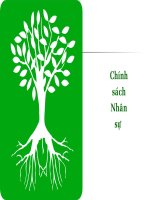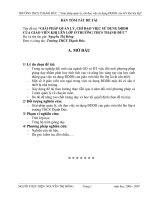DDDH SGK buổi 3
Bạn đang xem bản rút gọn của tài liệu. Xem và tải ngay bản đầy đủ của tài liệu tại đây (308.82 KB, 4 trang )
PRO 3M/3MPLUS – ƠN LUYỆN TỒN DIỆN CHO KÌ THI TỐT NGHIỆP THPT QUỐC GIA
Biên soạn: Cô Vũ Thị Mai Phương – Ngoaingu24h.vn
TÀI LIỆU ĐI KÈM LIVESTREAM
LUYỆN ĐỌC ĐIỀN - ĐỌC HIỂU ( TIẾP)
Theo dõi LIVESTREAM ĐỘC QUYỀN của cô vào lúc
20h30 ngày 26/9 duy nhất trên khóa học PRO 3MPLUS
Cô Vũ Thị Mai Phương
Read the following passage and mark the letter A, B, C or D to indicate the correct word or phrase that
best fits each of the numbered blanks.
ge
Pa
ai
:T
Every night, almost one billion people go to bed hungry. How can we feed all these (1) ________
people? Farmers all over the world have to content with weather, insects, and natural disasters, which are
capable of (2) ________ crops and ruining years of hard work. And the population is set to rise to nine
billion by 2050. Here are four possible solutions.
GM crops
Proponents of genetically modified crops (GM crops) claim that they will hugely (3) ________ food
production. Scientists have developed drought-resistant and disease-resistant crops, more productive
crops, and crops with increased vitamins. Anti-GM protesters worry (4) ________ health risks and
damage to other plants that grow near the GM crops.
Vertical farming
Another answer could be to grow food in buildings. (5) ________ of vertical farming are suggesting
we construct multistory, climate-controlled farm buildings in the heart of our cities. One indoor hectare
of land would be (6) ________ to above five hectares outdoors, so we could grow year-round crops that
would easily feed whole cities. Opponents point to the cost, the increased energy used and the effect on
farmers.
Eat less meat Others say the solution lies not (7) _______ new technologies, but in eating less meat.
It takes about seven kilos of corn to produce one kilo of beef. That quality of corn will keep more people
(8) ________ than that quality of beef. But this is a message the world doesn't want to hear. Meat
consumption is rising steeply.
Increase aid
Rich countries have far more food than they need and waste vast amount of it - 6.7 million tons a year
in the UK (9) ________. We can afford to send surplus food to people (10) ________ need it. We could
also simply give more money to developing countries, (11) ________ they can buy food. (12) ________
say that this makes people dependent on rich countries and is only a short-term solution.
Question 1. A. undernourished B. unhealthy
C. unbelievable
D. undeniable
Question 2. A. wasting
B. destroying
C. killing
D. harvesting
Question 3. A. strengthen
B. rise
C. increase
D. enlarge
Question 4. A. about
B. to
C. with
D. on
Question 5. A. Promoters
B. Advocates
C. Champion
D. Spokesmen
Question 6. A. same
B. parallel
C. alike
D. equivalent
Question 7. A. on
B. to
C. in
D. over
Question 8. A. alive
B. lively
C. vital
D. active
Question 9. A. lonesome
B. lone
C. lonely
D. alone
Question 10. A. whom
B. which
C. who
D. what
eu
Li
K
a
ho
ay
H
oc
H
n
ie
M
im
iK
Ph
an
V
KHÓA HỌC PRO3M/PRO3MPLUS – CHINH PHỤC ĐIỂM 9+ MÔN TIẾNG ANH CÙNG CÔ VŨ MAI PHƯƠNG
PRO 3M/3MPLUS – ƠN LUYỆN TỒN DIỆN CHO KÌ THI TỐT NGHIỆP THPT QUỐC GIA
Biên soạn: Cô Vũ Thị Mai Phương – Ngoaingu24h.vn
Question 11. A. because
Question 12. A. Reviewers
B. but
B. Critics
C. so
C. Analysts
D. since
D. Judges
ai
:T
ge
Pa
Read the following passage and mark the letter A, B, C or D to indicate the correct answer to each of
the questions.
Coral reefs are the most diverse of all marine ecosystems. They are full of life, with perhaps one
quarter of all ocean species depending on reefs for food and shelter. This is a remarkable statistic when
you consider that reefs cover just a tiny fraction of the earth's surface and less than two per cent of the
ocean bottom. Because they are so diverse, coral reefs are often called the rainforests of the ocean. Coral
reefs are very important to people. They even provide seventy per cent of the food demands for some
marine species, protection of shorelines, jobs based on tourism (nine out of twelve activities for tourists
in Nha Trang, for example, involve the coral reefs), and even medicines.
Unfortunately, climate change is the greatest global threat to coral reef ecosystems. Scientific
evidence now clearly indicates that the Earth's atmosphere and ocean are warming, and that these changes
are primarily due to greenhouse gases derived from human activities.
As temperatures rise, mass coral bleaching events and infectious disease outbreaks are becoming more
frequent. Additionally, carbon dioxide absorbed into the ocean from the atmosphere has already begun to
reduce calcification rates in reef-building and reef-associated organisms by altering seawater chemistry
through decreases in pH. This process is called ocean acidification.
Climate change will affect coral reef ecosystems, through sea level rise, changes to the frequency and
intensity of tropical storms, and altered ocean circulation patterns. When combined, all of these impacts
dramatically alter ecosystem function, as well as the goods and services coral reef ecosystems provide to
people around the globe.
There are also many things you can do to ensure that you are environmentally conscious when you
visit coral reefs or coastal areas. These include things such as hiring local guides to support the economy,
removing all trash from an area, never touching or harassing wildlife in reef areas, and avoiding dropping
your boat anchor or chain nearby a coral reef.
Finally, stay informed and spread the word! Educate yourself about why healthy coral reefs are
valuable to the people, fish, plants, and animals that depend on them. Your excitement will help others
get involved.
Question 13. Though the coverage of coral reefs on the sea bed is ________, its vital role is undeniable.
A. remarkable
B. small
C. diverse
D. huge
Question 14. _________ of all the ocean species find food and home in the coral reefs.
A. Two per cent
B. Seventy per cent
C. Twenty-five per cent D. Nine per cent
Question 15. Carbon dioxide from the atmosphere directly caused __________.
A. infectious disease outbreaks
B. reef-building
C. sea level rise
D. ocean acidification
Question 16. Which of the following statement is NOT true?
A. Coral reefs can be compared to rainforests due to its diversity.
B. The effects of global warming are only on the ecosystems themselves.
C. You can help the coral reefs by educating not only yourself but people around you.
D. Human activities which cause greenhouse gases are major reasons for the climate change.
Question 17. The word “conscious” in paragraph 5 is closest in meaning to _________.
A. knowledgeable
B. curious
C. aware
D. acknowledgeable
eu
Li
K
a
ho
ay
H
oc
H
n
ie
M
im
iK
Ph
an
V
KHĨA HỌC PRO3M/PRO3MPLUS – CHINH PHỤC ĐIỂM 9+ MƠN TIẾNG ANH CÙNG CÔ VŨ MAI PHƯƠNG
PRO 3M/3MPLUS – ƠN LUYỆN TỒN DIỆN CHO KÌ THI TỐT NGHIỆP THPT QUỐC GIA
Biên soạn: Cô Vũ Thị Mai Phương – Ngoaingu24h.vn
ai
:T
ge
Pa
Read the following passage and mark the letter A, B, C or D to indicate the correct answer to each of
the questions.
The poaching crisis wiping out Africa's elephants is costing the continent's economies millions in lost
tourism revenue, according to a new study. Researchers looked at visitor and elephant data across 25
countries, and modeled financial losses from fewer visitors in protected areas due to the illegal wildlife
trade, which has caused elephant numbers to plummet by more than 100,000 in the last decade. (A)
The study team combined visitor numbers across 164 protected areas in 25 countries in forest and
savannah elephants, and elephant population data from 2009 to 2013, to reach a “per elephant" value in
terms of tourism income.
They concluded that Africa was most likely losing $26m in tourism revenue a year. (B) Around $9m of
that is lost from tourists' direct spending, such as staying at hotels and buying crafts, with the rest through
indirect value in the economy such as farmers and other suppliers supporting the tourist industry.
The study, published in the journal Nature Communications, found that in most cases the revenue
losses were higher than paying for stronger anti-poaching measures to keep elephant populations stable.
(C) Dr. Robin Naidoo, the paper's lead author and , senior conservation wildlife scientist at WWF and his
team found. In the case of central Africa's forest elephants, which are harder for tourists to see and
therefore attract fewer visitors, the costs of protecting them exceed the benefits from tourism. Demand
from south-east Asia has seen the price of ivory triple since 2009 and it is estimated that one elephant is
killed every 15 minutes. (D) Corruption, a lack of resources, and, most importantly, increasingly
sophisticated poachers have hamstrung African countries' efforts to stem the trade.
Naidoo said that the research was not suggesting economic issues should be the only consideration
when protecting elephants, but framing the poaching crisis as a financial one could motivate African
governments and communities.
“It gives an additional reason for some groups of people, who may not necessarily be motivated by
intrinsic reasons for conversation, to engage with biodiversity conservation. It makes it clear to them that
it's not just in the best interests of the world to conserve this stuff, but tangible reasons for a whole different
group," he said.
Question 18. The overall profit that the continent lost a year can be estimated to ________.
A. 25 million USD
B. 100,000 USD
C. 26 million USD
D. 9 million USD
Question 19. Which of the following statements is TRUE?
A. To get to the conclusion, scientists compared the changes in number of tourists and number of
elephants in 2009.
B. The only reason why illegal poaching is so difficult to stop is corruption.
C. Protecting elephants is for the both the practical and immaterial reasons.
D. There is an argument over the differences in the balance between the loss and the cost to protect the
elephants.
Question 20. Which of the following statements is NOT true?
A. Across the continent, the amount of money spent on protecting the elephant is smaller than the loss
tourist industry is suffering from.
B. The number of tourists reduces because now it is more difficult for them to see the elephants in the
wild.
C. One reason why elephants are killed in mass volume is from the increasing market of ivory in South
East Asia.
D. Relating poaching to financial benefits can be considered as one of the solutions to the problem.
eu
Li
K
a
ho
ay
H
oc
H
n
ie
M
im
iK
Ph
an
V
KHÓA HỌC PRO3M/PRO3MPLUS – CHINH PHỤC ĐIỂM 9+ MÔN TIẾNG ANH CÙNG CÔ VŨ MAI PHƯƠNG
PRO 3M/3MPLUS – ƠN LUYỆN TỒN DIỆN CHO KÌ THI TỐT NGHIỆP THPT QUỐC GIA
Biên soạn: Cô Vũ Thị Mai Phương – Ngoaingu24h.vn
ai
:T
ge
Pa
Question 21. Which of the positions marked in the passage does the phrase "but the financial argument
did not stack up in all areas,” best fit?
A. (A)
B. (B)
C. (C)
D. (D)
Question 22. The word “plummet” in paragraph 1 is closest in meaning to ________.
A. fall
B. fluctuate
C. rise
D. stabilize
Question 23. The word “sophisticated” in paragraph 4 is closest in meaning to ____.
A. simple
B. outdated
C. advanced
D. basic
Question 24. The word “motivate” in paragraph 5 is closest in meaning to ____.
A. change
B. design
C. form
D. inspire
Question 25. Which of the following is the best title for the passage?
A. Elephant poaching costs African millions in tourism revenue
B. Elephant poaching does more good than harm
C. Elephant poaching brings an opportunity for Africa to change
D. Elephant poaching reduces the number of elephants in Africa
eu
Li
K
a
ho
ay
H
oc
H
n
ie
M
im
iK
Ph
an
V
KHÓA HỌC PRO3M/PRO3MPLUS – CHINH PHỤC ĐIỂM 9+ MÔN TIẾNG ANH CÙNG CÔ VŨ MAI PHƯƠNG









